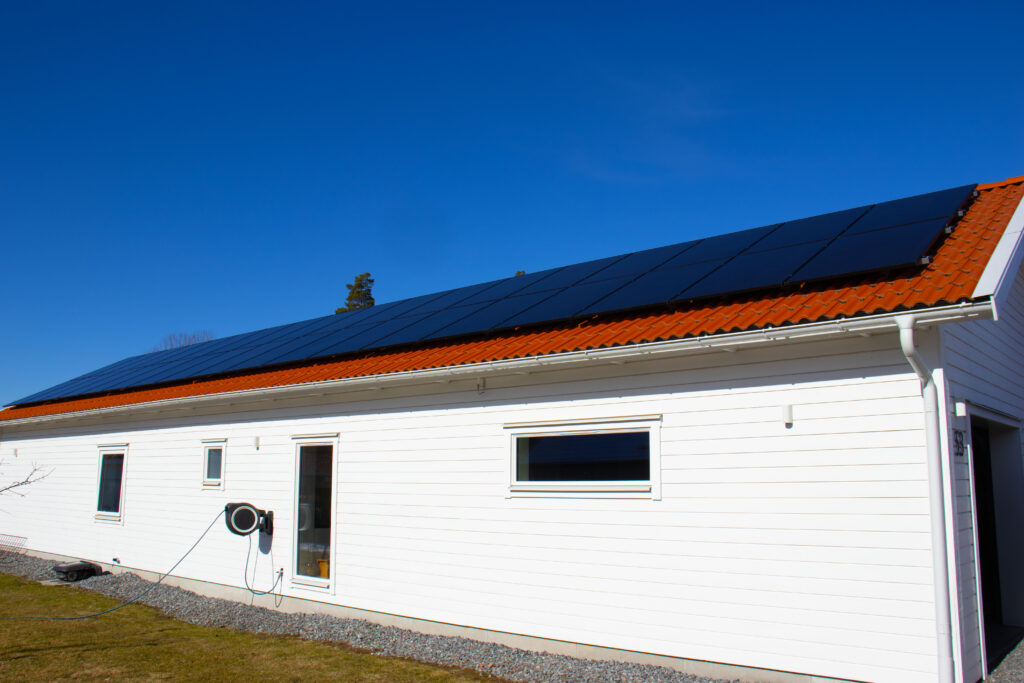
“The first thing the inspector said was that the PV system was insanely oversized, but he doesn’t know the purpose. Based on the purpose, it is very well dimensioned.”
Among the companies and major property owners nominated for Facility of the Year by the Swedish Solar Energy Association, there is an ordinary homeowner. But it’s not surprising. Fredrik Jonsson’s PV system is anything but ordinary, and everything is built around a Ferroamp system.
Fredrik Jonsson offers hamburgers straight from the electric grill when Ferroamp visits one day in mid-March. Although the snow is still melting on parts of the roof, he has a surplus of self-produced solar electricity in the system.
“It’s going to be Ferroamp grilled”, he says.
Fredrik Jonsson knew what he wanted even before he bought the villa in Hustahöjden in Västerås. Working in the IT industry, he likes data and wanted maximum visibility and control over his photovoltaic system. That’s why Ferroamp was the obvious choice.
“It was a choice. Do we want a “stupid” inverter that provides value for the 1800 hours a year the sun shines and is an expensive paperweight the rest of the time or do I want a system that adds value all 9000 hours of the year? If you look at the cost per operating hour, Ferroamp is a good investment”, he says.
Accurate data for correct decisions
Precisely because Ferroamp’s EnergyHub inverter is so much more than just an inverter, Fredrik made sure that it was installed in the house as early as one month after moving in in September 2022, nine months before the solar panels were installed. It was the smart electric car charging, phase balancing and, perhaps above all, the possibilities of measuring electricity consumption that Fredrik was interested in.
– You need accurate data to make correct decisions. Every homeowner should have an EnergyHub just for phase balancing and access to the meter data. You can see how your behaviour affects the power output, you can see if you have unevenly distributed loads on the phases and what you really need for fuse. The smartest thing to do is to install an EnergyHub before deciding which solar cells or battery to use. Then you get the decision-making data you need to dimension correctly”, says Fredrik, but adds that he himself did not dimension his facility in that way.
He was simply looking for a really big facility.

Self-sufficient during winter days
In total, Fredrik has installed 111 panels with a total of 43.5 kWp on the residential building and the garden shed. Fredrik chose to install solar panels in all directions and thus also use the north sides because he judged that production increased more than the cost.
“Many people have questioned why we installed panels on the north sides. But if you look at the production data, it’s only my largest southern strings that produce more than the north strings. It’s a lot of fun and a little unexpected.”
In the winter, a solar system in Sweden produces only 10 percent of the peak power, but with such a large system, it still meant that the family was self-sufficient and could even export electricity a week before Christmas Eve. Production over the full year is expected to be between 30-35 MWh, which is almost three times as much as consumption. Fredrik is well aware that this is not the usual way of dimensioning a photovoltaic system.
“This is a way to contribute to the electricity grid and the energy transition, but the fact that I’ve invested so much is also because it’s fun. says Fredrik.
Open system full of possibilities
The Ferroamp system uses open APIs that allow it to be integrated with other systems. This makes it possible for the owner of a system to find their own solutions, for example when it comes to visualising production and use. Fredrik has integrated the system into Apple’s HomeKit but also with the visualization tool Solar-Fox. There you can get an overview of the production but also how much carbon dioxide emissions have been avoided and how many other houses you supply with electricity each month.
The next step for Fredrik is to acquire batteries to increase the self-consumption of solar electricity production and the ability to control hourly prices, i.e. take advantage of the variations in electricity prices over the day. He also aims to participate in the market for support services.
And it is precisely the big picture with the many functions that Fredrik returns to when he talks about EnergyHub and the Ferroamp system, that it is so much more than an inverter for solar electricity.
“I firmly believe that a property owner is actually doing something wrong if they don’t get an EnergyHub, even if it’s just to access the meter data”, he says and laughs.
Dela insikten
News
Resources
EnergyCloud
About us
FERROAMP-PARTNER
Tools & support